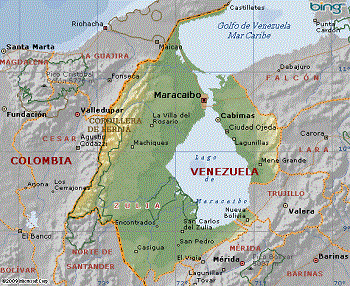A recent report on drug trafficking in Venezuelan border state Zulia draws attention to a key cocaine corridor that may become increasingly active in the near future.
There are various routes by which drug shipments are smuggled from Colombia into Zulia, local commander for the Bolivarian National Guard (Guardia Nacional Bolivariana – GNB) Alejandro Pérez Gámez told Panorama in a recent report.
One of the main routes begins in the small town of Paraguachón — in the northern Colombian department of La Guajira. Drug shipments are then moved along the Limón River towards the area south of Lake Maracaibo, Venezuela, and into the Zulia state capital Maracaibo.
From this city, drugs are frequently moved eastward across Lake Maracaibo’s General Rafael Urdaneta bridge and are then smuggled by highway into other Venezuelan states, particularly Lara and Falcón.
Some of the drugs are then sold on the local market, while other loads are trafficked to central Venezuela or to the Caribbean. Other highways are also used to move drugs into and out of the state of Tachira, which borders Zulia to the south.
SEE ALSO: Venezuela News and Profiles
So far in 2016, 26 people have been arrested on drug trafficking charges in Zulia state, Panorama reported.
While Pérez Gámez described Venezuela as a transit nation for illegal drugs, statistics show that the country, including Zulia state, is also a producer of narcotics. This year alone, three drug laboratories have been destroyed in the Zulia municipality of Jesús María Semprum. The same municipality also saw the discovery of 20 drug laboratories in the month of August 2014, according to GNB statistics.

A map of the drug trafficking route through Zulia state, Venezuela. Via Panorama
InSight Crime Analysis
Zulia’s position on the Colombian border makes it a highly strategic entry point for Colombian drug shipments, and this trend will probably only intensify in the short term.
Drug smuggling into Venezuela has traditionally taken place along two main routes. Firstly, there is the so-called “hot route,” identified in Panorama’s report, which goes through Zulia and up into Maracaibo. Then there is the “cold route,” which involves smuggling drugs into Venezuelan border city San Cristóbal, then across the mountains to national capital Caracas.
These routes could soon see increased activity thanks to rising cocaine production in neighboring Colombia, which recently regained its position as the world’s number one coca cultivator. According to US government figures, there were an estimated 159,000 hectares of coca crops in the country in 2015, with a potential to produce 420 metric tons of cocaine — the highest numbers seen since 2007.
SEE ALSO: Colombia News and Profiles
Zulia state is prime territory for increased traffic due to its location across the border from the Colombian sub-region of Catatumbo, in Norte de Santander department. US embassy sources told InSight Crime that Catatumbo has seen the greatest growth in cocaine production in Colombia over the past few years, and it may now be the biggest producer of coca leaf and cocaine hydrochloride in the country.
Colombian rebel groups control much of the border and have close ties to security forces in the region, increasing the potential for expansion of drug trafficking activities. Zulia state is allegedly a key base for top commander of the Revolutionary Armed Forces of Colombia (Fuerzas Armadas Revolucionarias de Colombia – FARC) Rodrigo Londoño Echeverri, alias “Timochenko,” and for members of the National Liberation Army (Ejército de Liberación Nacional – ELN)’s Central Command (Comando Central – COCE).
Another reason that Zulia may be seeing an increase in drug trafficking is the official closing of the main Colombia-Venezuela border crossing at Tachira by the Venezuelan government in August 2015. This may have pushed drug trafficking activity north into Zulia.

